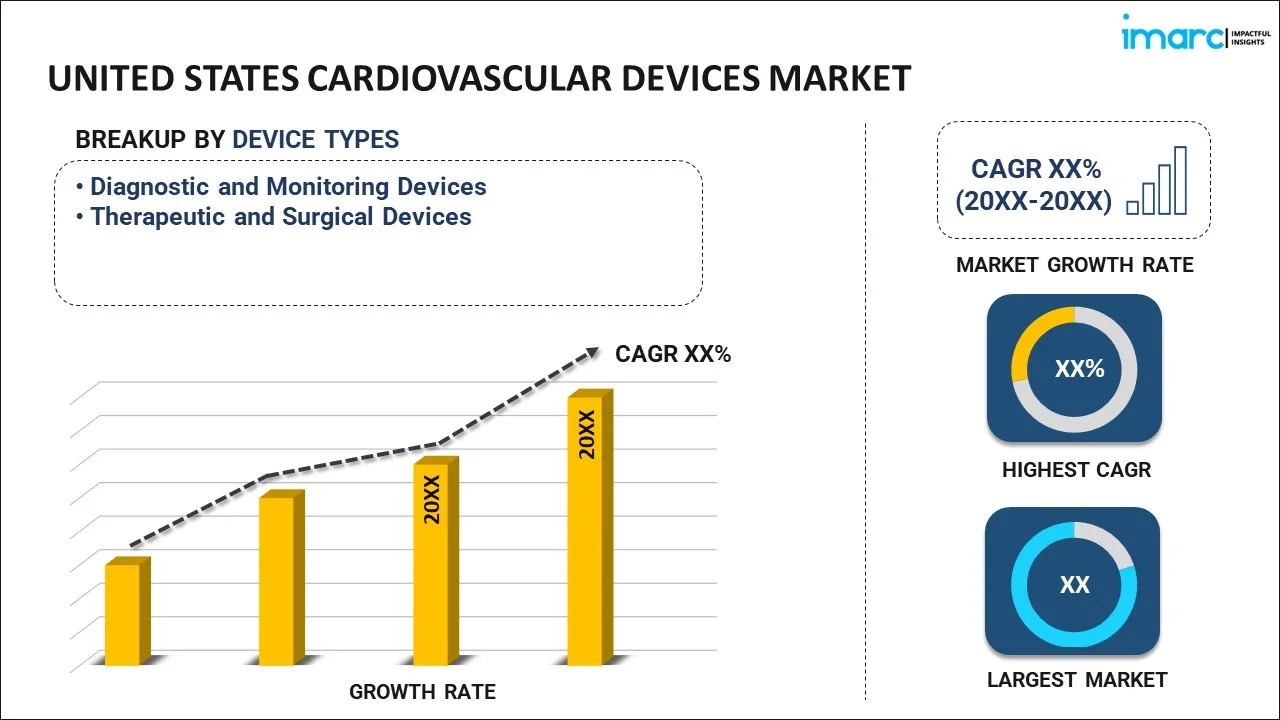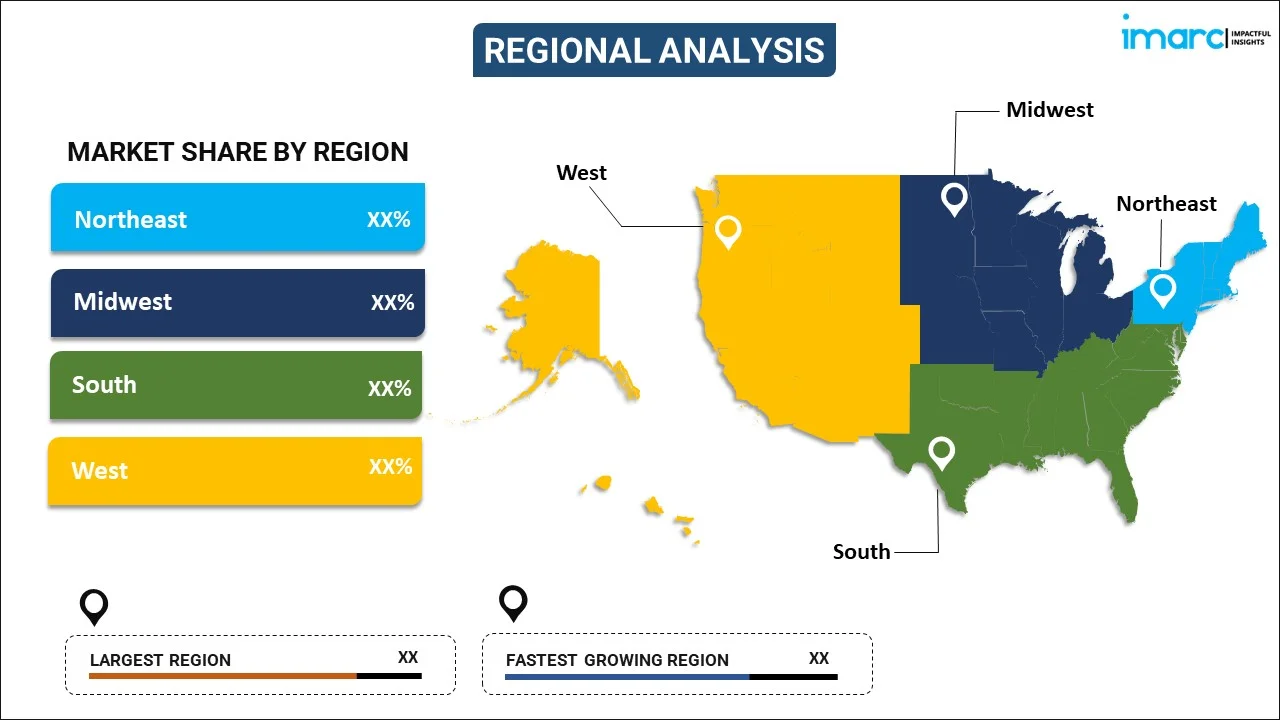
United States Cardiovascular Devices Market Report by Device Type (Diagnostic and Monitoring Devices, Therapeutic and Surgical Devices), Application (Coronary Artery Disease (CAD), Cardiac Arrhythmia, Heart Failure, and Others), End User (Hospitals, Specialty Clinics, and Others), and Region 2025-2033
Market Overview:
The United States cardiovascular devices market size is projected to exhibit a growth rate (CAGR) of 7.6% during 2025-2033. The prevalence of cardiovascular diseases, rapidly aging population, significant technological advancements, rising healthcare expenditure, health insurance coverage, government initiatives, increasing patient awareness and education, and research and development activities represent some of the key factors driving the market.
|
Report Attribute
|
Key Statistics
|
|---|---|
|
Base Year
|
2024 |
|
Forecast Years
|
2025-2033
|
|
Historical Years
|
2019-2024
|
| Market Growth Rate (2025-2033) | 7.6% |
Cardiovascular devices are medical tools designed to diagnose, treat, or manage various heart and vascular conditions. They play a crucial role in the field of healthcare, aiding both patients and medical professionals in maintaining cardiovascular health. These devices encompass a wide range of instruments and equipment, each serving a specific purpose. One common category of cardiovascular devices includes diagnostic tools such as electrocardiograms (ECGs) and echocardiography machines. These devices help in assessing heart function and identifying irregularities in heart rhythms or structural issues. Another vital group comprises therapeutic devices, like pacemakers and implantable cardioverter-defibrillators (ICDs), which are used to manage heart arrhythmias and ensure the heart functions properly. In addition to diagnostics and therapies, there are devices for monitoring and support. Continuous glucose monitoring systems, for instance, assist in tracking blood sugar levels in patients with diabetes, a condition often linked to cardiovascular problems. Furthermore, ventricular assist devices (VADs) and artificial hearts provide temporary or long-term support for individuals with severe heart failure while awaiting transplantation.
United States Cardiovascular Devices Market Trends:
Cardiovascular diseases, including heart disease and stroke, remain the leading cause of death in the United States. The high prevalence of these conditions has created a substantial demand for cardiovascular devices, ranging from diagnostic tools to therapeutic interventions. Additionally, the aging population in the United States is growing steadily. With age comes an increased risk of cardiovascular diseases. As the elderly population expands, there is a greater need for cardiovascular devices to address age-related heart conditions. Other than this, the country has one of the highest healthcare expenditures globally. This investment in healthcare infrastructure and services has contributed to the growth of the market, as healthcare providers and institutions invest in cutting-edge equipment and treatments. Besides this, access to health insurance coverage has expanded in recent years, increasing the affordability of cardiovascular procedures and treatments. This has led to more individuals seeking medical assistance for cardiovascular conditions, driving the demand for associated devices. In line with this, greater awareness about cardiovascular health and the importance of early detection has prompted individuals to seek medical advice and undergo diagnostic tests. This proactive approach contributes to the use of cardiovascular devices for preventive and early intervention purposes. Furthermore, extensive investment in research and development by both public and private entities has led to the development of groundbreaking cardiovascular devices. Collaborations between academic institutions and industry players drive innovation and market growth. Moreover, continuous advancements in medical technology have led to more effective and minimally invasive cardiovascular devices. Innovations, such as bioresorbable stents, remote monitoring systems, and improved imaging techniques have enhanced patient care and outcomes.
United States Cardiovascular Devices Market Segmentation:
IMARC Group provides an analysis of the key trends in each segment of the market, along with forecasts at the country level for 2025-2033. Our report has categorized the market based on device type, application, and end user.
Device Type Insights:

- Diagnostic and Monitoring Devices
- Electrocardiogram (ECG)
- Remote Cardiac Monitoring
- Others
- Therapeutic and Surgical Devices
- Cardiac Rhythm Management (CRM) Devices
- Catheter
- Stents
- Heart Valves
- Others
The report has provided a detailed breakup and analysis of the market based on the device type. This includes diagnostic and monitoring devices (electrocardiogram (ECG), remote cardiac monitoring, and others) and therapeutic and surgical devices (cardiac rhythm management (CRM) devices, catheter, stents, heart valves, and others).
Application Insights:
- Coronary Artery Disease (CAD)
- Cardiac Arrhythmia
- Heart Failure
- Others
A detailed breakup and analysis of the market based on the application have also been provided in the report. This includes coronary artery disease (CAD), cardiac arrhythmia, heart failure, and others.
End User Insights:
- Hospitals
- Specialty Clinics
- Others
The report has provided a detailed breakup and analysis of the market based on the end user. This includes hospitals, specialty clinics, and others.
Regional Insights:

- Northeast
- Midwest
- South
- West
The report has also provided a comprehensive analysis of all the major regional markets, which include Northeast, Midwest, South, and West.
Competitive Landscape:
The market research report has also provided a comprehensive analysis of the competitive landscape in the market. Competitive analysis such as market structure, key player positioning, top winning strategies, competitive dashboard, and company evaluation quadrant has been covered in the report. Also, detailed profiles of all major companies have been provided.
United States Cardiovascular Devices Market Report Coverage:
| Report Features | Details |
|---|---|
| Base Year of the Analysis | 2024 |
| Historical Period | 2019-2024 |
| Forecast Period | 2025-2033 |
| Units | Billion USD |
| Scope of the Report | Exploration of Historical and Forecast Trends, Industry Catalysts and Challenges, Segment-Wise Historical and Predictive Market Assessment:
|
| Device Types Covered |
|
| Applications Covered | Coronary Artery Disease (CAD), Cardiac Arrhythmia, Heart Failure, Others |
| End Users Covered | Hospitals, Specialty Clinics, Others |
| Regions Covered | Northeast, Midwest, South, West |
| Customization Scope | 10% Free Customization |
|
Post-Sale Analyst Support |
10-12 Weeks |
| Delivery Format | PDF and Excel through Email (We can also provide the editable version of the report in PPT/Word format on special request) |
Key Questions Answered in This Report:
- How has the United States cardiovascular devices market performed so far and how will it perform in the coming years?
- What has been the impact of COVID-19 on the United States cardiovascular devices market?
- What is the breakup of the United States cardiovascular devices market on the basis of device type?
- What is the breakup of the United States cardiovascular devices market on the basis of application?
- What is the breakup of the United States cardiovascular devices market on the basis of end user?
- What are the various stages in the value chain of the United States cardiovascular devices market?
- What are the key driving factors and challenges in the United States cardiovascular devices?
- What is the structure of the United States cardiovascular devices market and who are the key players?
- What is the degree of competition in the United States cardiovascular devices market?
Key Benefits for Stakeholders:
- IMARC’s industry report offers a comprehensive quantitative analysis of various market segments, historical and current market trends, market forecasts, and dynamics of the United States cardiovascular devices market from 2019-2033.
- The research report provides the latest information on the market drivers, challenges, and opportunities in the United States cardiovascular devices market.
- Porter's five forces analysis assist stakeholders in assessing the impact of new entrants, competitive rivalry, supplier power, buyer power, and the threat of substitution. It helps stakeholders to analyze the level of competition within the United States cardiovascular devices industry and its attractiveness.
- Competitive landscape allows stakeholders to understand their competitive environment and provides an insight into the current positions of key players in the market.
Need more help?
- Speak to our experienced analysts for insights on the current market scenarios.
- Include additional segments and countries to customize the report as per your requirement.
- Gain an unparalleled competitive advantage in your domain by understanding how to utilize the report and positively impacting your operations and revenue.
- For further assistance, please connect with our analysts.
 Inquire Before Buying
Inquire Before Buying
 Speak to an Analyst
Speak to an Analyst
 Request Brochure
Request Brochure
 Request Customization
Request Customization




.webp)




.webp)












